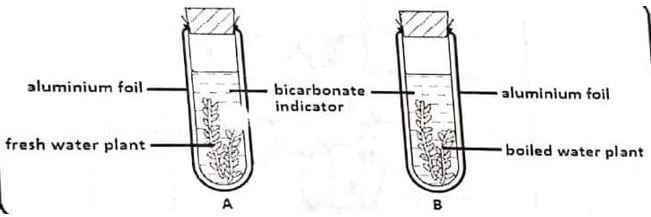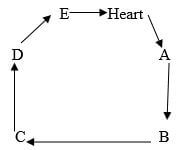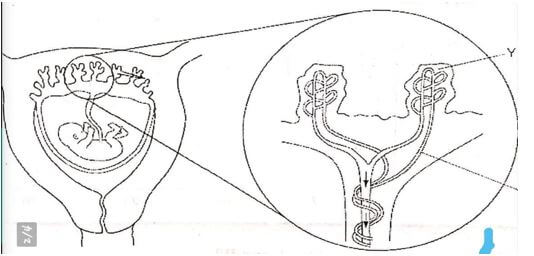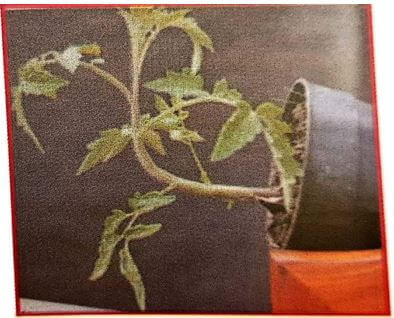QUESTIONS
-
- Define the following terms as used in Biology
- Chemosynthesis (1 mark)
- Mutualism (1 mark)
- State the importance of photosynthesis in nature (2 marks)
- Define the following terms as used in Biology
- What is the importance of the stroma in the chloroplast? (2 marks)
- Name two cell structures that synthesize the following cell organelles
- Ribosomes (1 mark)
- Lysosomes (1 mark)
- Name three plant leaf excretory products (3 marks)
- A student mixed a sample of urine from a patient with Benedict’s solution and boiled the mixture
The colour changed to orange- What was present in the urine sample? (1 mark)
- What did the student conclude about the health status of the patient? (2 marks)
- Which organ in the patient may not be functioning properly? (1 mark)
- Name two types of values in the heart (2 marks)
- Sometimes when one stands up very quickly after a long period of sitting, she may feel faint or dizzy Explain (2 marks)
- The cardiac muscles are said to be myogenic What is the meaning of the term myogenic (1 mark)
- A Form 3 student carried out an experimental set up as shown below
Bromothymol blue is sensitive to pH change (bromothymol is yellow in low pH)
- What was the aim of the experiment? (1 mark)
- Why was set up B included in this experiment? (1 mark)
- Why was aluminium foil used in this experiment? (1 mark)
- Explain why bromothymol changed its colour from blue to yellow in tube A after 30 minutes (1 mark)
- Differentiate between the cell wall found in fungi and the one in plants (2 marks)
- State three adaptations that enable prey to evade predators (3 marks)
- The diagram below represents a simplified trend of nitrogen circulation in an ecosystem

- What is the descriptive term applied to each of the organisms A and D
A ................................................
D ................................................ - Name each of the processes (3 marks)
- Marked B
- Facilitated by organisms D
- One group of organisms that can act as saprophytes
- Name the chemicals C, F and E
C ................................................
F ................................................
E ................................................
- What is the descriptive term applied to each of the organisms A and D
- The diagram below is a summary of the sequence of blood flow through the heart and associated blood vessels

- Name the blood vessels labelled A and E (2 marks)
A ................................................
E ................................................ - State two differences between blood vessel B and D (2 marks)
- State two adaptations of the blood vessel labeled C to its functions (2 marks)
- Name the blood vessels labelled A and E (2 marks)
- How does light as a biotic factor influence the distribution of plants in an ecosystem? (3 marks)
- Seed germination is affected by certain plant growth regulators
Describe two actions of gibberellins during seed germination (2 marks) - The diagram below shows a foetus in the uterus

- Name two substances that will be at a higher concentration at Y that at X (2 marks)
- State two observable adaptations of the placenta to its functions (2 marks)
-
- Name the genetic disorder in humans that is characterized by inability of blood to clot (1 mark)
- A female human was found to have an extra sex chromosome in her cells
- Give the total number of chromosomes in the male individual’s cells (1 mark)
- Explain the possible causes of this condition (2 marks)
- State two physical characteristics observed in the female individual with such a condition (2 marks)
-
- Explain why fossil records as evidence of organic evolution are usually incomplete (3 marks)
- Name the evidence of organic evolution exhibited by occurrence of similar amino acid molecules in a range of organisms (1 mark)
- Bumble bees are insects that live in the arctic tundra They have adaptations to keep their body temperature above that of the environment One adaptation is shivering which involves rapid muscle contraction A second adaptation is a very hairy body
Explain how those adaptations help to keep the body temperature above that of the environment (3 marks) - The photograph below shows a bone from an animal

-
- Identify the bone shown (1 mark)
- Give one reason for your answer (1 mark)
- Name the body region from which the bone was obtained (1 mark)
- State three adaptations of the bone in the photograph to its functions (3 marks)
-
- The photograph below shows a potted plant in horizontal position

- Name the type of response shown (1 mark)
- State the biological significance of the response above to the plant (1 mark)
- Explain the mechanisms of the response (4 marks)
-
- State the class to which the plant belongs (1 mark)
- Give one reason for your answer (1 mark)
MARKING SCHEME
-
- Define the following terms as used in Biology.
- Chemosynthesis (1 mark)
- Process whereby non-green /some bacteria utilize energy derived from chemical reactions in their bodies to manufacture food from simple substances in the environment;
- Mutualism (1 mark)
- Mode of nutrition/feeding relationship, between two organism where both organisms benefit.
- Chemosynthesis (1 mark)
- State the importance of photosynthesis in nature. (2 marks)
- Regulation of carbon (IV) oxide and oxygen gases in the environment.
- Enables autotrophs make their own food meet their nutritional requirements;
- Convert light energy into chemical energy that can be utilized by other organisms that are unable to manufacture their own food;
- Define the following terms as used in Biology.
- What is the importance of the stroma in the chloroplast? (2 marks)
- Contains enzymes necessary for photosynthesis
- Forms site for light independent reactions.
- Name two cell structures that synthesize the following cell organelles.
- Ribosomes (1 mark)
- Nucleolus
- Lysosomes (1 mark)
- Centriole
- Ribosomes (1 mark)
- Name three plant leaf excretory products. (3 marks)
- Quinine, Khat, Papain
- A student mixed a sample of urine from a patient with Benedict’s solution and boiled the mixture.
The colour changed to orange.- What was present in the urine sample? (1 mark)
- Reducing sugars/Glucose/Monosaccharides
- What did the student conclude about the health status of the patient? (2 marks)
- The patient has diabetes mellitus
- Which organ in the patient may not be functioning properly? (1 mark)
- Patient’s pancreas isn’t functioning well/Pancreas producing very little/insufficient insulin.
- What was present in the urine sample? (1 mark)
- Name two types of values in the heart. (2 marks)
- Atrio-ventricular valves/Cuspid valves.
- Semi – lunar valves.
- Sometimes when one stands up very quickly after a long period of sitting, she may feel faint or dizzy. Explain. (2 marks)
- The rapid change in posture alters the body’s blood distribution; causing a temporary/ ack of blood in the brain;
- The cardiac muscles are said to be myogenic. What is the meaning of the term myogenic.(1 mark)
- Ability to initiate contraction from within without nervous stimulation;
- A Form 3 student carried out an experimental set up as shown below.
Bromothymol blue is sensitive to PH change (bromothymol is yellow in low PH)
- What was the aim of the experiment? (1 mark)
- To show CO2 is produced during respiration in plants;
- Why was set up B included in this experiment? (1 mark)
- It’s a control experiment; Rej. Acts as a control experiment.
- (c) Why was aluminium foil used in this experiment? (1 mark)
- To prevent light from illuminating the leaf;
- Explain why bromothymol changed its colour from blue to yellow in tube A after 30 minutes. (1 mark)
- Due to lack of light, no photosynthesis occurs; respiration occurs producing CO2; which accumulates in the test tube resulting into acidic conditions that turn the indicator yellow;
- What was the aim of the experiment? (1 mark)
- Differentiate between the cell wall found in fungi and the one in plants. (2 marks)
- Cellwall in fungi is made of chitin; while in plants it’s made of cellulose;
- State three adaptations that enable prey to evade predators. (3 marks)
- Mimicry/Resemblance of some organisms to other organisms or objects making the prey unrecognizable/unpalatable;
- Agility/Ability to move fast to escape predators;
- Defense mechanisms e.g. powerful hind legs to kick off predators spines to prick predators/production of foul smells to repel predators.
- The diagram below represents a simplified trend of nitrogen circulation in an ecosystem.

- What is the description term applied to each of the organisms A and D.
- A Nitrogen fixing bacteria;
- D Nitrifying bacteria;
- Name each of the processes. (3 marks)
- Marked B Ammonification; Acc Excretion
- Facilitated by organisms D Nitrification.
- One group of organisms that can act as saprophytes Fungi/Bacteria;
- Name the chemicals C, F and E.
- C - Ammonia;
- F - Nitrites;
- E - Nitrates;
- What is the description term applied to each of the organisms A and D.
- The diagram below is a summary of the sequence of blood flow through the heart and associated blood vessels.

- Name the blood vessels labelled A and E. (2 marks)
- A - Artery
- E - Veins
- State two differences between blood vessel B and D. (2 marks)
B
D
Carry oxygenated food away from the heart to all body organs except pulmonary artery; umbilical artery; renal artery
Carry deoxygenated blood from the body to the heart except pulmonary vein, umbilical vein; renal vein
- State two adaptations of the blood vessel labeled C to its functions. (2 marks)
- Narrow/small diameter to facilitate contact with many cells.
- Semi-permeable to allow selective movement of materials across it.
- Thin endotherm/single layer of cells to reduce diffusion distance for faster diffusion/provide a shorter pathway for easy access to tissue fluid.
- Smooth inner surface to allow smooth flow of materials
- Numerous to provide a large surface area for exchange of materials.
- Name the blood vessels labelled A and E. (2 marks)
- How does light as a biotic factor distribution of plants in an ecosystem? (3 marks)
- Light influences photosynthesis/opening and closing of the stomata; opening and closing of flowers; Growth of plants; germination.
- Seed germination is affect by certain plant growth regulators.
- Describe two actions of gibberellins during seed germination. (2 marks)
- Breaks seed dormancy; Acts on aleurone layer; amylase/hydrolytic enzymes activity increased/starch digestion affected; effect on protein synthesis.
- Describe two actions of gibberellins during seed germination. (2 marks)
- The diagram below shows a foetus in the uterus.

- Name two substances that will be at a higher concentration at Y that at X. (2 marks)
- Nutritional wastes
- Carbon (IV) oxide;
- Antibodies;
- State two observable adaptations of the placenta to its functions. (2 marks)
- Have (Chorionic) villi to provide a large surface area for exchange of materials between mother and foetus;
- Have a thick epithelium to reduce diffusion distance for faster exchange of materials between mother and foetus
- Highly vascularized for faster transportation of exchange of materials between the mother and the foetus;
- Secretory/Glandular to secrete progesterone.
- Name two substances that will be at a higher concentration at Y that at X. (2 marks)
-
- Name the genetic disorder in humans that is characterized by inability of blood to clot. (1 mark)
- Haemophilia;
- A female human was found to have an extra sex chromosome in her cells.
- Give the total number of chromosomes in the female individual’s cells.(1 mark)
- 47 chromosomes
- Explain the possible causes of this condition. (2 marks)
- Non-disjunction during spermatogenesis or oogenesis
- State two physical characteristics observed in the male individual with such a condition. (2 marks)
- Infertility due to lack of sperm production.
- Underdeveloped testis
- Reduced facial hair
- Usually taller than average with signs of obesity (Accept first 2)
- Give the total number of chromosomes in the female individual’s cells.(1 mark)
- Name the genetic disorder in humans that is characterized by inability of blood to clot. (1 mark)
-
- Explain why fossil records as evidence of organic evolution are usually incomplete.(3 marks)
- Only partial preservation of the organism occurs because softer parts decay hence incomplete records;
- Distortion during sedimentation;
- Destruction due to geological activities; e.g. erosion, earthquakes, faulting and uplifting
- Name the evidence of organic evolution exhibited by occurrence of similar amino acid molecules in a range of organisms. (1 mark)
- Comparative serology
- Explain why fossil records as evidence of organic evolution are usually incomplete.(3 marks)
- Bumble bees are insects that live in the arctic tundra. They have adaptations to keep their body temperature above that of the environment.
One adaptation is shivering which involves rapid muscle contraction.
A second adaptation is a very hairy body.
Explain how those adaptations help to keep the body temperature above that of the environment. (3 marks)- Shivering is due to contraction and relaxation of muscles which generates energy; (that is supplied throughout the body to maintain body temperature);
- The hair; trap air that insulates the body against heat loss;
- The photograph below shows a bone from an animal.

-
- Identify the bone shown. (1 mark)
- Thoracic vertebra; Rej. Thoracic vertebrae
- Give one reason for your answer. (1 mark)
- Have a long (backward facing) neural spine;
- Have short transverse processes;
- Have capitular and tubercular facets;
- Identify the bone shown. (1 mark)
- Name the body region from which the bone was obtained. (1 mark)
- Thoracic region
- State three adaptations of the bone in the photograph to its functions. (3 marks)
- Have a long (backward facing) neural spine which offers a large surface area for attachment of back muscles;
- Have a prominent Centrum for support of body weight/support vertebral column/for articulation with the ribs;
- Have the tubercular facets on each transverse process that articulates with the tubercular of the ribs;
- Have post zygopophysis for articulation with adjacent vertebrae;
(Acc – First 3)
-
- The photograph below shows a potted plant in horizontal position

- Name the type of response shown. (1 mark)
- (Negative) Geotropism
- State the biological significance of the response above to the plant. (1 mark)
- Enables the shoot to obtain light for photosynthesis;
- Enables the shoot to expose flowers for pollination.
- Enables the shoot to keep fruits away from the soil to avoid rotting of fruits; (Any one)
- Explain the mechanisms of the response. (4 marks)
- Gravity causes auxins to diffuse to the lower side of the shoot; hence higher auxins concentration on the lower side then the upper side;
- Higher concentration of auxins on the lower side of the shoot causes faster/rapid cell division and cell elongation/growth than on the upper side; causing the curvature upward;
-
- State the class to which the plant belongs. (1 mark)
- Dicotyledonae;
- Give one reason for your answer. (1 mark)
- Leaves have network veins
- State the class to which the plant belongs. (1 mark)
- Name the type of response shown. (1 mark)
Download Biology Paper 1 Questions and Answers - Bunamfan Post Mock 2021 Exams.
Tap Here to Download for 50/-
Get on WhatsApp for 50/-
Why download?
- ✔ To read offline at any time.
- ✔ To Print at your convenience
- ✔ Share Easily with Friends / Students

